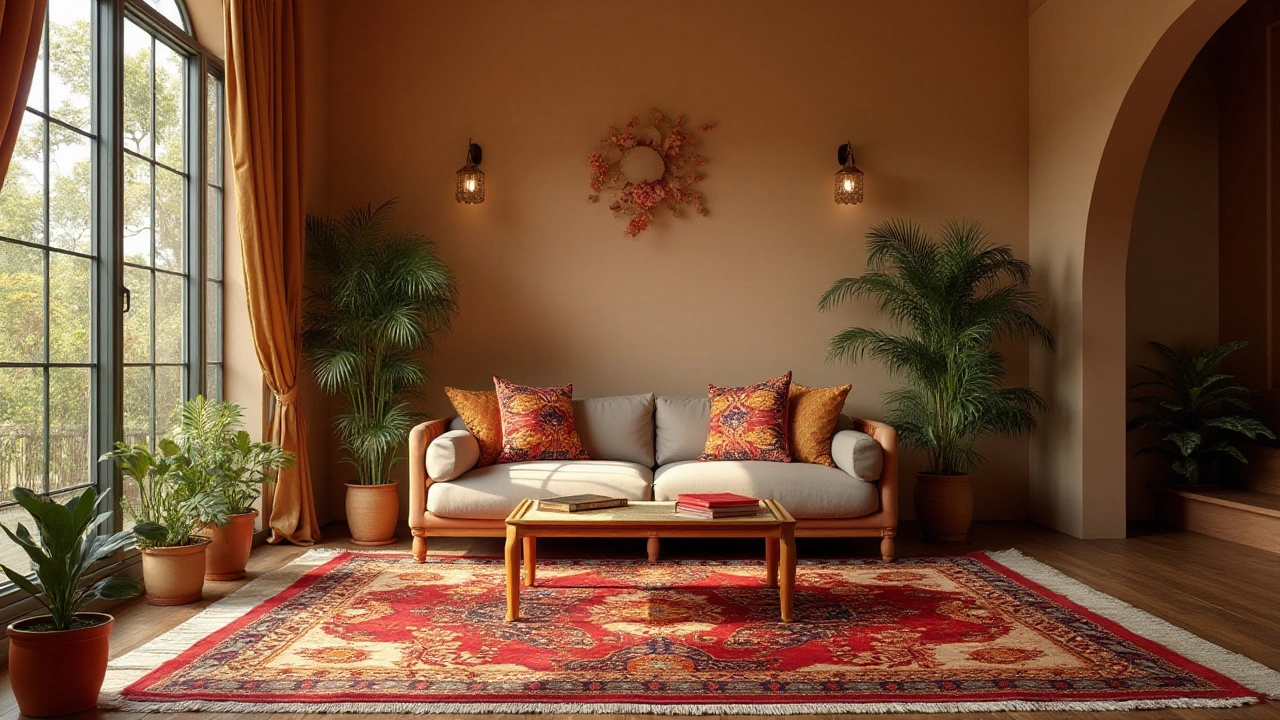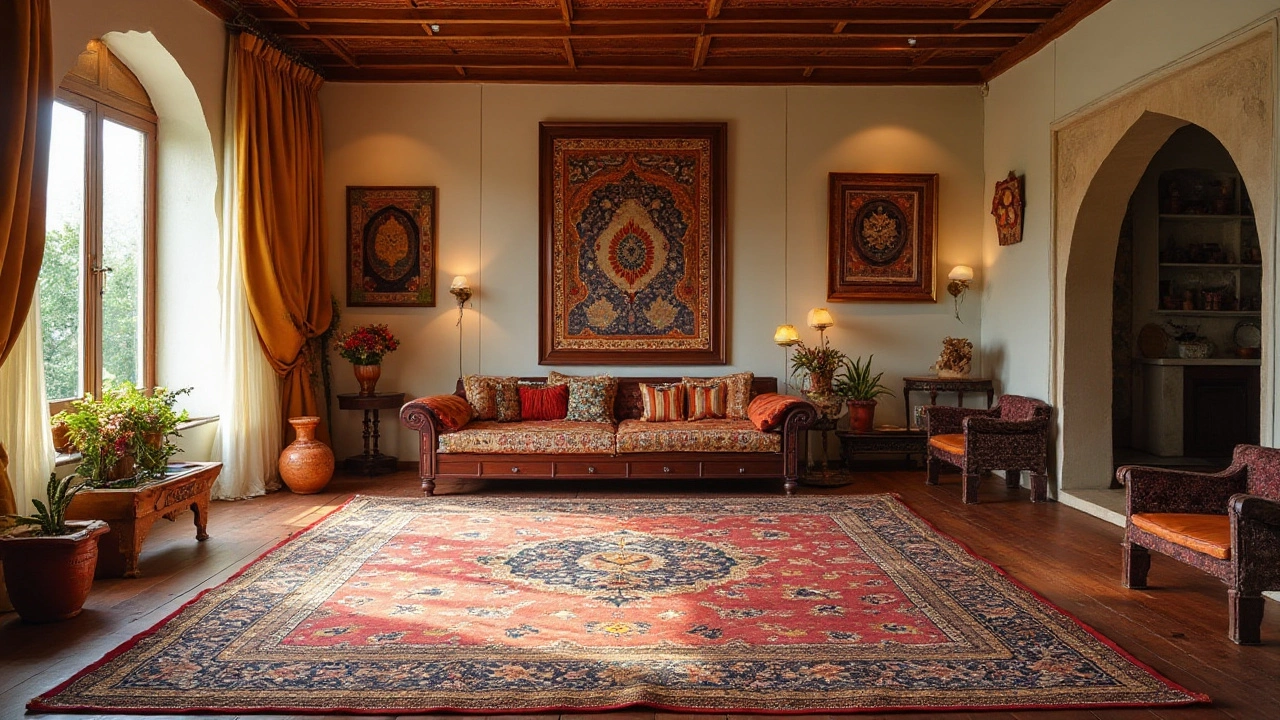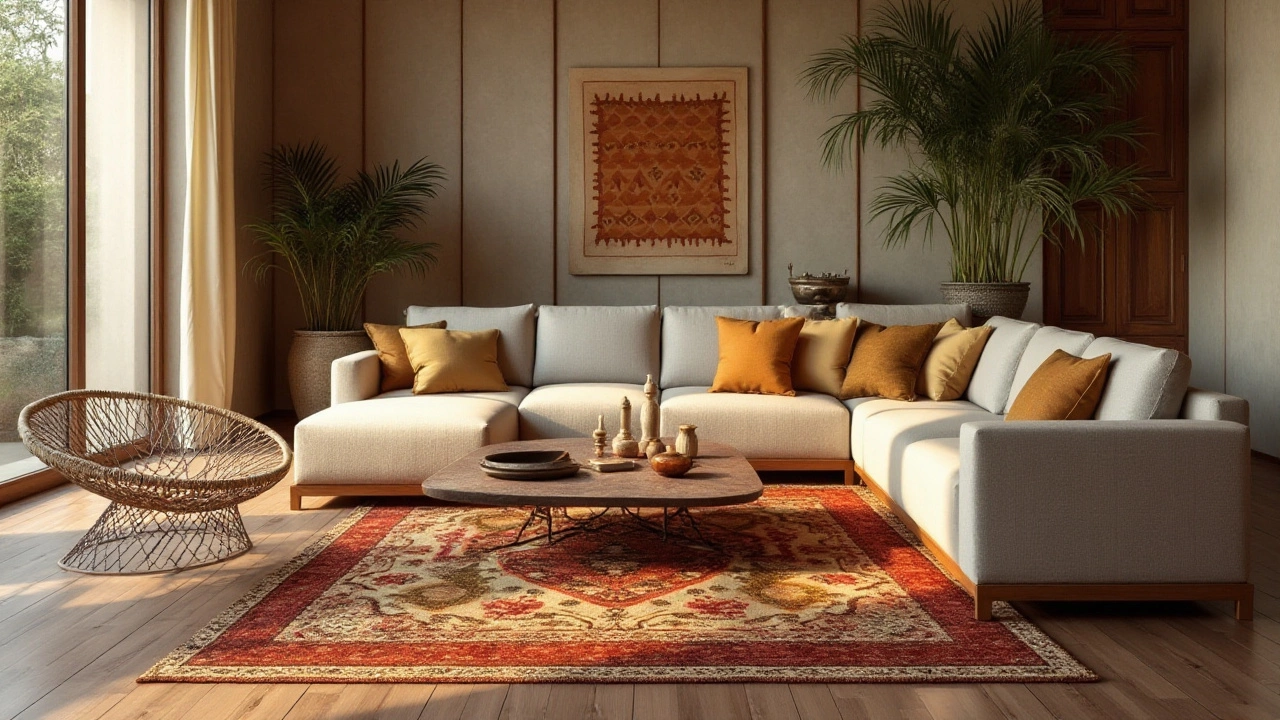Choosing the Perfect Rug Size for Your Couch

Selecting a rug to go under your couch isn't just about the aesthetics; it's an art that combines function and style to elevate your living space. In today's home decor, rugs play a pivotal role in pulling together the look and ambiance of a room. They provide not only a statement piece under your furniture but also set the tone for comfort and flow. So, how do you choose the perfect size that complements your couch while enhancing the overall feel of your living space?
You start by considering the dimensions of your room and the layout of your furniture. It's crucial to strike a balance where the rug anchors the space but doesn't overwhelm it. Too small, and the room feels disjointed; too large, and it might swallow the furniture arrangement. Perfecting this balance is key to a well-styled and functional living area.
- Understanding Rug Dimensions
- Common Rug Sizes for Couches
- Measuring Your Space
- Style Tips for Rug Placement
- Avoiding Common Mistakes
Understanding Rug Dimensions
When diving into the world of home decor, the task of selecting the right rug size often sneaks up on us. It's an element that seems simple at first but can make or break the harmony of a room. Every piece of furniture in our living space has a role, with the couch often playing the lead. However, the unsung hero might just be the rug beneath it, making dimensions something of a science and an art.
The size of your rug should relate to both the dimensions of your room and your furniture arrangement. For a standard living room where the average couch spans about 84 inches in length, a typical rug size might range from 8x10 feet to 9x12 feet. These measurements allow the rug to extend under the couch and provide ample space for the front legs of chairs or side tables, creating a cohesive unit. According to Anna Graham, a leading interior designer, "A rug should anchor your furniture not just for aesthetics but for harmony in foot traffic as well."
It's also crucial to consider how much floor you want visible around the rug. Ideally, there should be about 18 inches of bare floor around the perimeter of the room, letting the rug breathe without it appearing cramped. This isn’t just about looks. The space helps with the visual flow, preventing the room from feeling congested. Imagine walking through a gallery, where the framing and whitespace add elegance and accessibility to visual pieces. The same principle applies to living spaces; rugs are the frames that ground and present the furniture like fine art.
The proper rug placement involves both art and a bit of technical measurements. You need your living room rug to unify the furniture grouping while maintaining a middle ground. That means a variety of options depending on individual preferences. Some like all the furniture to sit on the rug, which often requires larger sizes, while others might opt for just the front legs of the couch to rest on the rug, providing a balanced look. It's about personal preference and the balance of elements within the room at large.
A simple way to experiment with dimensions before purchasing is to use painter's tape on the floor to outline potential rug sizes. This visual representation provides a clear picture of how each size will fit and flow within the space. Remember, the rug is like a stage, setting the scene for all activities in your living room, from cozy movie nights to lively gatherings.
To give you an insight into popular choices and to back decisions with data, take a look at this breakdown of rug sizes typically chosen for varied dimensions:
| Room Type | Average Dimensions | Recommended Rug Size |
|---|---|---|
| Small Apartment Living Room | 10x12 feet | 5x8 feet or 6x9 feet |
| Medium Family Room | 12x18 feet | 8x10 feet |
| Large Open Concept Space | 20x20 feet | 9x12 feet or 10x14 feet |
By understanding these dimensions and experimenting with options, you'll be in the best position to find a rug size that seamlessly integrates with your home, elevating not just your couch but the whole living experience within the room.
Common Rug Sizes for Couches
When it comes to placing a living room rug under your couch, the size you choose can make a world of difference in how your space feels and functions. Traditionally, there are several sizes that people frequently choose based on the layout of their room and the size of their furniture. The three main categories are small, medium, and large rugs, each serving a unique purpose in your living area. Small rugs, typically around 5x8 feet, are great for more compact spaces or for placing solely under a coffee table. Medium rugs, like those around 8x10 feet, are versatile and can accommodate the front legs of your sofa, providing a cohesive look without overwhelming the room. Then we have large rugs, commonly around 9x12 feet or more. These are perfect for larger furniture arrangements where you want all pieces, including couches and chairs, to sit comfortably on the rug and define the entire living space.
Picking the right size often hinges on the furniture layout and personal preferences, but it's not just about dimensions. It's about creating visual harmony between the size of the rug and the expansiveness of your room. As renowned interior designer Nate Berkus eloquently puts it,
"A rug can ground the space, but choosing the proper size ensures it speaks with the room, not shouts."Indeed, a well-chosen rug size can lead the eye across the room invitingly, enhancing the existing decor, and promoting a sense of coziness. Many decorators suggest that at least the front legs of your couch should rest on the rug to help anchor the area and prevent the parts of the rug that extend out from looking like mismatched accessories.
For those venturing into open-floor plans or larger living spaces, a large rug can serve a dual purpose of covering ample floor real estate while also carving out specific zones without needing physical partitions. Such rugs, often above 9x12 feet, embody more than just a covering for tile or hardwood; they instill a framework and promote conversation in a socially engaging manner. Gauging the appropriate size can also depend on high-traffic areas. You wouldn’t want an edge of the rug to become a trip hazard or, inversely, leave a spot feeling both stark and unfinished. Offsetting this dynamic market balance between comfort and practicality requires not only an eye for size but a touch of practical foresight—appreciating that a large rug might need a sizeable investment in maintenance, especially in busy households.
To put decisions into perspective, consider these useful statistics: Around 80% of new homeowners in the UK add a rug to their lounge within the first year, often citing warmth and style as primary factors. Interestingly, a well-placed rug has been noted to promote a sense of comfort that transcends mere aesthetics, enhancing acoustics by minimizing echo—no mean feat in homes with high ceilings or sparse furnishing.
Ultimately, choosing a common rug size under your couch should feel both intuitive and informed. It’s about harmonizing personal taste with expert tips, practical necessities, and the unique architectural nuances of your space. Remember, your home is your canvas, and the right rug doesn’t just complement your space—it completes it.

Measuring Your Space
Before you choose the perfect rug size for your living area, it’s crucial to get a comprehensive understanding of your space’s layout. You might think that simply measuring the available floor space will do the trick, but there’s so much more to consider. Start by identifying the main purpose of the room; whether it's a cozy corner for reading or an entertainment hub for the family. This will guide how much of the floor you actually want to cover with a rug. Next, take a step back and observe the room from different angles to get a good view of how the furniture is arranged. This will help you visualize how a rug can enhance or detract from the flow and function of the space. Essentially, you want your rug to define areas within the room without making it feel bottled up.
Once you've established the room’s purpose and observed the space, it’s time to grab your measuring tape. Begin by measuring the length and width of the space where you plan to position your rug. It's wise to measure in feet or meters rather than relying on eye judgments. This precise measurement will inform your choices when you're shopping for a living room rug. It's especially important if you have a couch in place, as your rug should adequately fit either under all four legs of the couch or at least the front two. Leaving enough room between the edge of the rug and the walls gives the room a border-like feel and ensures the space doesn't appear cramped.
The next step is to consider any pathways or routes that might overlap with the rug’s territory. A rug tucked into a high-traffic area can show wear faster and might interfere with the natural movement within the room. You might want to keep a few pathways rug-free to maintain the room's accessibility. To be precise, plan these routes ahead and measure how much of the rug will be trafficked. A good balance will employ rugs not just as protection for floors, but as visual guideposts for the furniture layout.
It's interesting to note some statistics regarding the most common rug placements. A recent survey showed that about 70% of interior designers suggest an 8x10 foot rug as the go-to size for an average UK living room. These dimensions often can accommodate either the entire arrangement of furniture on top or just a partial cover, leaving room for personalization based on personal taste and traffic patterns. A smaller 5x8 foot rug might serve well in more compact spaces or underneath a smaller sofa.
"Rug placement can either make or break a room," asserts well-known interior designer Kelly Wearstler. "It's not just about style; it's the interplay with the room's architecture that truly makes it magical."
After all these considerations, always remember to factor in the other elements in the room, like the color schemes and material patterns of both the furniture and curtains. A rug can be a beautiful anchor that ties these elements together harmoniously. In the end, taking the time to measure correctly saves a lot of hassle and ensures that the couch area rug you pick will be the star of the room.
Style Tips for Rug Placement
Arranging a living room rug under your couch is more than just sliding it under and calling it a day. It involves thoughtful planning and a keen eye for design to ensure the rug plays a harmonious role in your living space. So, what are the key considerations when it comes to placing your rug?
Firstly, consider the placement in terms of proportion and alignment. A common technique is to have the front legs of your couch resting on the rug while leaving the back legs off. This technique, often recommended by interior decorators, is called 'anchoring', and it helps in visually connecting the furniture pieces within the area. In contrast, placing a rug with all furniture legs on it creates a more cohesive look, ideal for open-plan spaces where you want to define a distinct seating area. Both methods are sound, but the choice largely depends on room size and personal preference.
When you're working with a smaller space, playing with patterns and colors can be a game-changer. A boldly patterned rug size can bring a dynamic element to your living area, and when it mirrors or complements the couch or surrounding decor, the effect is magnified. On the other hand, a neutral rug can be perfect for spaces where the couch or other furniture pieces are meant to be the star. Balancing bold patterns with muted tones often results in a visually delightful environment and sets a welcoming atmosphere.
Lighting, too, goes hand-in-hand with rug placement. Natural light tends to soften colors and can make a room feel more open, influencing your choice of color and material. Rugs placed under couches in naturally lit rooms often benefit from soft, lighter colors which help maintain a casual and relaxed feel. Conversely, if your room relies primarily on indoor lighting, darker or richly patterned rugs can lend a sumptuous warmth to the area.
Practicality is another essential factor. For high traffic areas, choosing a rug material that is durable and easy to clean is a smart decision. Rugs made of wool or a synthetic blend are typically preferred in family rooms or spaces where pets roam. These materials not only stand up well to wear but also offer a soft and cozy underfoot experience. Consider how much wear and tear your rug will face and adjust your choices accordingly.
Many design experts emphasize the importance of considering both comfort and appearance when choosing a rug. As one well-regarded designer puts it, "A rug is the heart of a room. It both grounds you and ties together the elegance of the space."
"A well-chosen rug doesn't just sit beneath a couch; it completes the room," says Emily Henderson, a renowned interior stylist whose designs decorate homes worldwide.Her words remind us that aesthetics and functionality must go hand-in-hand when styling our living environments.

Avoiding Common Mistakes
When it comes to choosing the right rug size for your couch, there are several common pitfalls that homeowners frequently fall into, often without even realizing it. One of the most notable mistakes is selecting a rug that is too small, which can make the area surrounding your couch feel fragmented and the room appear cluttered. It disrupts the flow and can leave an awkward gap between the edge of the rug and the couch or other furnishings. This mistake is particularly prevalent as many people underestimate the visual impact a larger rug can have in terms of creating warmth and unity in a space.
Another common error is not aligning the rug with your room's specific dimensions. This oversight can cause an imbalance that detracts from the harmony you're aiming to create. A good rule of thumb is ensuring that your rug extends at least a few inches beyond the sides and front of your couch. A rug that is too short can create a visually disruptive "floating" effect for the furniture, detaching the couch from the intended cozy feel. Statistics from interior design surveys indicate that homes with appropriately sized rugs often report higher satisfaction levels with their living room arrangement.
It's also important to consider the placement of other furniture pieces. For example, if you have a coffee table in front of your couch, make sure that its base either sits entirely on the rug or not at all. Any awkward seating arrangements can emerge if half the legs are on the rug and half are off it, which can create a sense of instability both visually and practically. Interior stylists often advise to "anchor your coffee table," a tip that can bring cohesion and grounded comfort to a living space.
"A room should never allow the eye to settle in one place. It should smile at you and create fantasy," says Juan Montoya, a renowned interior designer.
Color coordination is another mistake that's often overlooked. A mismatch in rug colors can clash with your existing decor, disrupting the visual balance of the room. To avoid this, consider picking a rug with a color that complements your furniture or walls, tying the room’s elements together smoothly. According to a survey by home decor experts, choosing a rug with at least one color that matches an element in the room can significantly increase a room's aesthetic appeal.
Finally, neglecting to measure before buying a rug is an all-too-common slip-up, easily avoidable with a little preparation. Plan ahead by measuring the floor area you're willing to cover, taking into account all the furniture, from the couch to the chairs and tables. Using painter’s tape can be a handy way to visualize the size and fit of your new rug before making a purchase. This strategic preparation can prevent costly mistakes and ensure that your living space comes together just as you envisioned.